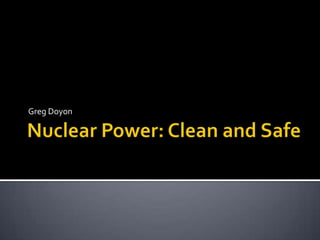
Nuclear Power: A Cleaner Alternative to Reduce CO2 Emissions
- 1. Greg Doyon
- 2. Intro Arguments Policy Brief Challenges to Nuclear Power Conclusion
- 3. Nearly all of our electricity is powered by fossil fuels, especially coal Coal combustion for electricity and power is the world’s largest source of anthropogenic Carbon Dioxide release Excessive Carbon Dioxide is dangerous to the environment and to human health In 2009, the EPA announced that carbon dioxide and 5 other greenhouse gases threaten public health and the environment
- 4. This public health toxin can be eliminated or at least reduced by the use of Nuclear power fueling this country and worldwide. Nuclear power is cleaner and more efficient; however, it comes with a negative branding due to historical catastrophes of some nuclear power plants.
- 5. The world is too dependent on fossil fuels, such as coal, to produce electricity. Environmental air pollution linked has been linked to carbon dioxide. This air pollution has been known to cause an increase in respiratory diseases such as Asthma, lung cancer, and heart diseases, as well as liver, nerve, and kidney damage. (US Department of Energy, 2011)
- 6. Study, linked CO2 emissions and an increase in deaths: Computer models were used to determine the amounts of ozone and airborne particles that result from temperature increases caused by increases in carbon dioxide emissions. Ozone causes and worsens respiratory and cardiovascular illnesses, emphysema and asthma, and many published studies have associated increased ozone with higher mortality. Bergeron, L. (2008, January 3). Stanford Report. Study links carbon dioxide emissions to increased deaths .
- 7. Summary of severe* accidents in energy chains for electricity 1969-2000 OECD NON-OECD Energy Chain: Fatalities: Fatalities/TW/y Fatalities: Fatalities/TW/y : : Coal 2,295 157 18,000 597 Natural Gas 1,043 85 1,000 111 Hydro 14 3 30,000 10,285 Nuclear 0 0 31 48 Data from Paul Scherrer Institut, in OECD 2010. * severe = more than 5 fatalities (Paul Scherrer Institut, 2012) TW/y = terawatt per year 1 TW = 1 Trillion Watts
- 8. Fossil fuel combustion. It provides 70% of our electricity. Its emissions kill 24,000 Americans per year (70,000 deaths—that’s about 1,200 Chernobyls per year—if diesel and gasoline emissions are included). Coal burning alone annually emits 2.5 gigatons of CO2. Commercial nuclear power. It contributes 21 percent, has never caused a single death to the public in the US, and, because it doesn’t burn anything, makes 73% of our virtually emissions-free electricity—the equivalent of annually taking 68 million automobiles off the road.” (Cravens, 2009)
- 9. Provide more funding to nuclear research, especially in the aspect of storing the spent fuel rods and radioisotopes. Entitle the government to own some of the constructed nuclear power plant, and provide the defense necessary to defend from terror threats Phase out the use of fossil fuel power plants within 12 years As the phasing out occurs, renewable resources will help fill in the void, as nuclear energy starts up and fossil fuels phase out. 6 Nuclear power plants (3 in the North: East, Midwest, and West and 3 in the South: East, Midwest, and West) should be already constructed before the phasing out of fossil fuel power plants begins
- 10. There have been 3 major accidents with nuclear power plants in our history, Three Mile Island, Chernobyl, and Fukushima. These 3 accidents have given nuclear power a bad reputation. The United States used nuclear power as a weapon against Japan in WWII. We have seen the type of damage nuclear radiation can do. Cost Fossil Fuels are much cheaper than Nuclear Power, as well as, our complete energy infrastructure being based off of Fossil Fuels would mean even more costs to change any structural needs and build power stations Storing of nuclear radioisotopes and spent fuel rods Terror threats A terrorist attack on a nuclear power plant could be devastating
- 11. Coal and other fossil fuel plants emit too much CO2 CO2 is dangerous to human health as well as environmental health Nuclear Power is much cleaner and safer for humans and the environment With research, we will be able to develop proper technologies to store radioisotopes and prevent nuclear meltdowns or leaks. Government will be allowed to own a certain percentage of the Power Plant, to ensure defense against Terrorist attacks. Nuclear power can be a reliable source of energy, as it will not deplete natural resources nearly as fast as fossil fuels
- 12. Cravens, G. (2009, July 2). Nuclear Power is the Only Alternative. Seed Magazine . Paul Scherrer Institut. (2012, February). World Nuclear Association. Retrieved March 11, 2012, from Safety of Nuclear Power Reactors: http://www.world- nuclear.org/info/inf06.html US Department of Energy. (2011, March 8). How can air pollution hurt my health? Retrieved March 11, 2012, from Lawrence Berkeley National Laboratory: http://www.lbl.gov/Education/ELSI/Frames/pollution- health-effects-f.html Bergeron, L. (2008, January 3). Stanford Report. Study links carbon dioxide emissions to increased deaths .